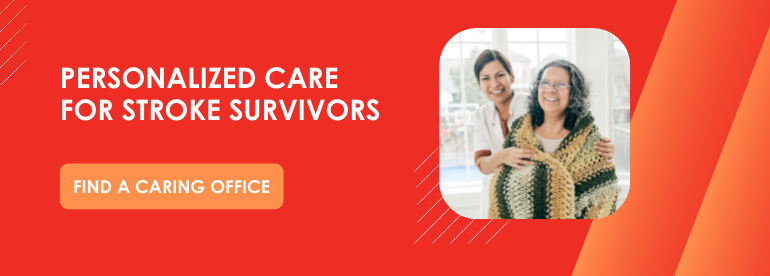Many seniors and their loved ones are aware of some of the serious warning signs of a stroke, like arm weakness, difficulty speaking, and face drooping. But did you know that this medical emergency — which affects around 800,000 Americans every year — comes in different forms?
Strokes can be broken down into three distinct types: ischemic strokes, hemorrhagic strokes, and transient ischemic attacks (TIA). Each type of stroke is caused by different factors in your brain, body, and cardiovascular system. And each type can affect the body differently. By understanding the different types of strokes and what contributes to each you and your loved one can stay educated in the fight against strokes.
Strokes: The Basics
Throughout your body, your cardiovascular system pumps nutrient-rich, oxygen-rich to every organ, including your brain. Strokes are associated with an interruption in that all-important blood flow in the brain. Whether this occurs as a result of a clot, a blockage, or a rupture, the results can be devastating. Without the influx of oxygen and nutrients supplied from blood, cells and tissues die very quickly in the affected parts of the brain.
How Strokes Damage Different Parts of the Brain
Brain cells can start to die just 5 minutes after losing their supply of oxygen-rich blood. Depending on which brain tissues are targeted, a stroke can damage different functions.
- Cerebrum: Your cerebrum takes up 2/3 of your brain's weight and is divided into left and right hemispheres. When a stroke damages blood cells in the cerebrum, you might experience changes in speech, movement, eating, reason, memory, perception, and emotional control.
- Cerebellum: Located at the back of the skull, your cerebellum helps you with coordination and balance. If you have a stroke that impacts this part of your brain, you might have trouble with walking, balance, and dizziness.
- Brain Stem: Strokes that affect the brain stem can have serious consequences, including death. Situated right over your spinal cord, your brain stem helps control vital functions like breathing and heartbeat. Strokes in this part of the brain can impact heart and breathing function, and cause paralysis and coma.
3 Major Types of Strokes
Every stroke comes with a unique set of challenges and issues. This has a lot to do with which parts of the brain are impacted, but also depends on the type of stroke you or a loved one experiences:
1. Ischemic Stroke
Let's talk about the most common type of stroke first. Ischemic strokes account for 87% of all strokes. The word ischemia means restriction of blood supply. In this type of stroke, one of the arteries that supplies the brain becomes blocked by a blood clot, which is a culmination of fatty deposits within the blood vessel walls.
These blood clots may develop in the brain itself, resulting in a thrombotic stroke, or the blood clot may develop elsewhere in the body and travel to the brain, resulting in an embolic stroke.
In some cases, doctors can administer a medication that helps dissolve the clot. In other cases, they might have to remove the clot through a mechanical treatment.
WHO'S AT RISK FOR ISCHEMIC STROKES?
Unfortunately, the risk of ischemic strokes increases with age. Most people who suffer from these are 60 years or older, and women are more commonly affected by men.
Often, a thrombotic stroke is caused by atherosclerosis, a condition where the blood vessels become narrow or blocked due to the buildup of plaque. Embolic strokes are often caused by atrial fibrillation, which is associated with an irregular heartbeat that causes blood to pool in the upper chambers of the heart and leads to a clot.
However, you may be at a higher risk of developing a blood clot if you are obese, have certain health conditions, have high cholesterol, smoke, or eat poorly.
HOW DO YOU PREVENT ISCHEMIC STROKES?
Doctors agree that controlling risk factors like high blood pressure, managing atherosclerosis, and keeping high cholesterol under control can make a huge difference in your risk for an ischemic stroke. Try establishing a regular exercise routine and focusing on your diet.
2. Hemorrhagic Stroke
The next type of stroke is a hemorrhagic stroke. The word hemorrhage refers to blood releasing from a ruptured blood vessel. So, while ischemic strokes are caused by clots and blockages, hemorrhagic strokes stem from burst blood vessels. Blood vessels may burst or leak blood if they become weak or hardened over time.
When blood from a ruptured vessel spills into the brain, it damages brain tissue and cells through increased swelling and pressure. Often, hemorrhagic strokes require surgery to remove the blood, repair damaged blood vessels, and relieve the excess brain pressure.
There are 2 different kinds of hemorrhagic stroke:
- Intracerebral: An intracerebral hemorrhage is caused by bleeding inside the brain itself. Associated with aneurysms — in which a weakened or damaged blood vessel bulges and bursts — an intracerebral hemorrhage floods the brain with blood. The leaked blood then causes massive swelling, increases pressure in the brain, and releases cell-damaging toxins.
- Subarachnoid: Also caused by a burst aneurysm, a subarachnoid stroke simply occurs in a different part of the brain. It targets the space between the brain and the tissue that covers the brain.
WHO'S AT RISK FOR HEMORRHAGIC STROKES?
As in all strokes, individuals with high blood pressure are at a higher risk for hemorrhagic strokes. High blood pressure puts unnecessary force on your arteries and veins, causing them to weaken over time.
However, it can be difficult to predict an aneurysm, since blood vessels can age along with the rest of the body and simply become more likely to rupture. In addition, some people are born with abnormally formed blood vessels that are prone to become weak and burst, while others may suffer from head trauma that makes them more prone to hemorrhagic strokes.
HOW DO YOU PREVENT HEMORRHAGIC STROKES?
To prevent the risk of hemorrhagic strokes, it's important to avoid smoking cigarettes and drinking excessive alcohol. You should also take measures to manage your blood pressure, including working with your doctor, evaluating your diet, and regularly exercising.
3. Transient Ischemic Attack
Also known as a TIA, a transient ischemic attack occurs when blood flow to the brain is briefly interrupted. Though they don't usually cause lasting brain damage or death, they serve as a warning sign that a person is at risk for strokes in the future.
TIAs can be the result of a small blood clot that temporarily blocks blood flow. Just like an ischemic stroke, TIAs can happen when the clot builds up in the brain or when it travels to the brain from another part of the body. The difference here, however, is that TIAs are temporary and only disrupt blood flow for a short amount of time.
Symptoms often resolve within 24 hours, but transient ischemic attacks still require immediate medical intervention. A physician will work with you to identify why the TIA occurred and help you reduce your risk factors for a future stroke.
WHO'S AT RISK FOR TIAS?
Like the other types of stroke, the risk of TIAs rises as we age. But some factors may increase a senior’s risk of a TIA.
- High blood pressure
- Smoking cigarettes
- Diabetes
- Blood clots and atherosclerosis
- Heart disease
HOW DO YOU PREVENT TIAS?
To prevent TIAs, you should work to remain as healthy as possible. Manage any existing health conditions, and pay close attention to your blood pressure and cholesterol levels.
For seniors and their loved ones, strokes can be life-changing and even life-threatening. Knowing about the different types of strokes can help you stay educated about this dangerous medical issue.
To learn about the warning signs of a stroke, download our free resource: Warning Signs of a Stroke. We also have a downloadable stroke risk factor assessment to help you or a loved one determine your risk of stroke and to provide practical tips to reduce that risk. Find your local Caring office to download our free resources.


